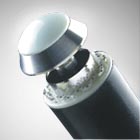


Circular Staplers
* Esophagectomy,Gastrectomy,Small intesting and
Colon Excision Operation,Rectum low antrior resection

Linear Cutter Staplers
* General Surgery, Chest Surgery,Gynecology
and the parenchyma Excision,transection,reforger and anastomose of pediatric Operation.
More than 70,000 children visit ER for medical device-related injuries, complications
Each year, more than 70,000 children and teens visit the emergency room as a result of medical device injuries, according to national estimates published this week online in Pediatrics; contact lenses were the top culprit.
Researchers, led by the U.S. Food and Drug Administration's Dr. Cunlin Wang, studied numbers from the National Electronic Injury Surveillance System All Injury Program database from Jan. 1, 2004 through Dec. 21, 2005 and found that there were 144,799 medical device-related complications during those two years.
Nearly a quarter of medical device-associated adverse events (MDAE) resulted from contact lens problems, which are preventable, the researchers wrote. They point out that common factors related to contact lens complications and injury result from improper cleaning techniques and wearing the lenses for too long.
"The involvement of parents during the entire process of lens-fitting, care and follow-up monitoring is critical," the researchers wrote.
Other common problems the researchers found include punctures from hypodermic needles, infections in children with ear tubes, and injuries such as skin tears from gynecological devices in examining teen girls.
Injuries from medical devices didn't usually warrant hospitalization unless caused by implanted medical devices, the report said. Hospitalizations decreased with older patients. The most prevalent type of injuries included contusions and abrasions, foreign-body intrusions, punctures, lacerations and infections. And the most affected body parts included the eyeball, pubic region, finger, face and ear.
While Dr. Steven Krug, head of the division of emergency medicine at Children's Memorial Hospital in Chicago, isn't surprised by these findings, he says they are an important first step in gaining insight to pediatric medical device complications.
"It's the first time I've seen something like this," he told DOTmed News. "There should be surveillance...to learn about devices with higher-than-acceptable malfunction rate or [devices] associated with unusually high unusual complications."
This report shouldn't scare people away from pediatric medical devices, he pointed out.
"Devices are important. Without devices, many kids [with health problems] can't survive," he said. "Devices are generally wonderful, but of course, there is a burden for patients and their families."
Website: www.medicalstapler.com
